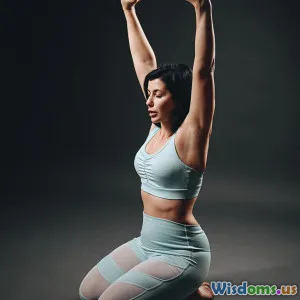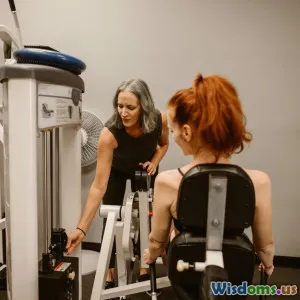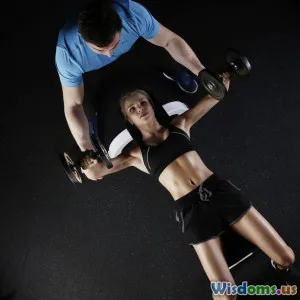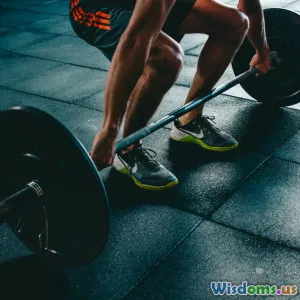
Ten Resistance Band Exercises for Full Body Toning
13 min read Discover ten resistance band exercises to tone your entire body, featuring clear guidance, expert tips, and inspiring benefits to help you achieve full-body fitness anywhere. (0 Reviews)
Ten Resistance Band Exercises for Full Body Toning
Introduction
What if achieving a leaner, stronger, and balanced physique didn’t require an expensive gym membership or bulky equipment? Imagine a workout tool so portable it fits in your backpack, yet powerful enough to sculpt every muscle. Enter resistance bands — a simple yet transformative tool embraced by everyone from elite athletes to home workout enthusiasts.
Resistance bands have skyrocketed in popularity due to their affordability, versatility, and efficiency. According to a 2022 survey by the Physical Activity Council, over 25% of home fitness enthusiasts relied on resistance bands to stay fit during lockdowns.
In this article, we'll unravel ten of the most effective resistance band exercises designed for full body toning. Whether you’re new to fitness or seeking to spice up your routine, these exercises offer a balanced blueprint for comprehensive strength and flexibility. Plus, you’ll learn coaching tips, the special benefits resistance bands provide, and how to avoid common mistakes.
So grab your band, and let’s get stretching, strengthening, and sculpting!
Why Resistance Bands?
Versatility Meets Effectiveness
Resistance bands aren’t merely a stand-in for dumbbells or cable machines—they’re uniquely effective. Their elastic resistance means your muscles face tension through every part of an exercise, not just at the peak of movement. This results in greater muscle activation and consistent progress.
"When you use resistance bands, you recruit stabilizing muscles in a way that doesn't always happen when you work with free weights," notes Dr. Jordan Metzl, sports medicine physician, in Men’s Health.
Ideal for All Fitness Levels
Whether you’re recovering from injury or building up to a heavy lift, resistance bands come in a variety of thicknesses and tension levels. This flexibility makes them ideal for novices and seasoned athletes alike. Adjusting your resistance is as simple as swapping out your band or changing your grip.
Portability and Accessibility
Throw them in your suitcase for an effective travel workout, or use them at home with minimal space—resistance bands are the epitome of convenient training tools.
Additional Benefits
- Joint-Friendly: Low-impact nature makes them safer for joints.
- Improved Mobility: Bands enhance both strength and flexibility.
- Injury Prevention & Rehab: Widely used by physical therapists.
Getting Started: Safety & Tips
Before jumping into the exercises, keep these foundational tips in mind:
- Warm Up First: Always start with dynamic stretches and light movement to prepare joints and muscles.
- Choose the Right Resistance: Select a band that challenges you but allows for proper form. Lighter bands are best for small muscles and mobility; heavier bands suit larger muscle groups.
- Check Band Condition: Inspect for tears or overstretching to avoid breakage during exercise.
- Mind the Form: Quality reps over quantity—doing exercises correctly ensures better results and lowers the risk of injury.
The Ten Resistance Band Exercises for Full Body Toning
Each of the following exercises targets a major muscle group or movement pattern, ensuring total-body engagement. Integrate them into a circuit or use them individually to tailor your toning routine.
1. Squat with Shoulder Press
Targets: Quads, glutes, shoulders, core
How to Do It:
- Stand on the band, feet hip-width apart.
- Hold the handles (or ends) at shoulder height.
- Perform a deep squat; as you stand up, press the arms overhead like a shoulder press.
Tip: Keep your knees tracking over toes and core engaged. This exercise fuses lower and upper body engagement for calorie-torching, full-body toning.
Real-World Example: Fitness professionals love this for functional strength. In group classes, pairing squat with a press is touted for maximized muscle coordination and heart rate elevation.
2. Banded Row
Targets: Upper back, lats, rear deltoids, biceps
How to Do It:
- Loop the band around sturdy furniture or close it in a door at chest height.
- Stand back, feet shoulder-width, gripping the band ends.
- Row elbows back, squeezing your shoulder blades together; control the return.
Tip: Focus on posture—avoid shrugging.
Data Insight: According to the National Strength and Conditioning Association, horizontal pulling (rows) is crucial for maintaining shoulder health and balancing push-dominant movements in most routines.
3. Deadlift
Targets: Hamstrings, glutes, lower back, forearms
How to Do It:
- Stand on the band with feet hip-width apart.
- Grab the handles or looped ends with both hands.
- With back straight, push the hips back, keeping slight knee bend; return to standing.
Tip: Concentrate on hip movement over knee bend. Squeeze glutes at the top.
Why It’s Great: The band adds resistance while still protecting your lower spine—key for longevity and safe progress.
4. Chest Press
Targets: Chest, triceps, shoulders
How to Do It:
- Anchor band behind you (e.g., door hinge).
- Hold handles at shoulder height, palms down.
- Step forward with one foot, press arms straight in front, then control back.
Tip: Vary stance for stability; control both extension and release for max muscle activation.
Example: Professional trainers often substitute band chest presses for dumbbells to allow for more movement patterns and easier joint impact adjustments.
5. Lateral Band Walk
Targets: Glute medius, hip flexors, thighs
How to Do It:
- Loop a smaller band just above your knees.
- Assume a half-squat, feet hip-width apart.
- Step sideways, maintaining squat, never letting knees collapse inwards.
Tip: Keep tension on the band throughout.
Benefits: This move is a staple in athletic warm-ups and rehab, targeting often-underused glute muscles for hip stability and injury prevention.
6. Banded Reverse Lunge with Curl
Targets: Glutes, quads, hamstrings, biceps, stability muscles
How to Do It:
- Stand on the band with your front foot.
- Hold handles; as you step back into a lunge, simultaneously curl the band up with your arms.
Tip: Maintain upright posture and full control through the curl and lunge.
Coaching Point: Pairing lower and upper body engagement increases heart rate and caloric burn. Athletes perform combo moves for improved efficiency and muscle synergy.
7. Standing Tricep Extension
Targets: Triceps, shoulders, core stability
How to Do It:
- Anchor band under one foot or behind you.
- Bring handles overhead, elbows close to ears.
- Extend arms up, then return with control.
Tip: Don’t let elbows flare wide; core remains firm.
Fact: Strong triceps not only tone the arm but are crucial for everyday pushing movements—from getting out of a chair to carrying groceries.
8. Woodchop Twist
Targets: Core (obliques), shoulders, hips
How to Do It:
- Anchor band low.
- Stand side-on, holding the end in both hands.
- With arms straight, rotate and pull the band upwards across your body; slowly return.
Tip: Generate movement from the torso, not just arms.
Evidence: Rotational movements improve functional strength for sports and daily activities involving twisting, like golf and tennis.
9. Seated Band Leg Press
Targets: Quads, glutes, calves
How to Do It:
- Sit on the floor, loop band around feet, hold ends.
- Start with knees bent; press both legs out as if on a leg press machine.
- Return with control.
Tip: Avoid jerking the band; focus on smooth extension for consistent tension.
Insight: This move is accessible for those rehabbing lower body injuries and needing safe, progressive overload.
10. Face Pull
Targets: Upper back (rear deltoids, traps), rotator cuff
How to Do It:
- Anchor band at face level.
- Grip ends, arms extended.
- Pull the band toward your face, elbows high and wide, squeezing shoulder blades.
Tip: Focus on moving from the shoulders, not the neck.
Why It Matters: Keeping upper back muscles strong offset desk-job posture and supports healthy shoulders. Physical therapists widely prescribe face pulls for postural correction.
Bonus: Integrating the Workout
Here’s how to build these exercises into an effective routine:
- Full Body Circuit: Choose 5-6 of the above, perform each for 10-15 reps, 2-3 rounds.
- Split Routine: Select 3 lower and 3 upper body moves for alternating days.
- Time-Efficient Flows: Pair two moves (e.g., squat to press + row) in supersets for maximum muscle engagement and calorie burn in less time.
Sample Full-Body Band Workout:
- Squat with Press x 12
- Banded Row x 15
- Deadlift x 12
- Chest Press x 15
- Lateral Band Walk x 20 steps
- Tricep Extension x 12
Repeat the circuit 3 times with 45 seconds rest between rounds.
Real-World Success Stories
Ben, a software engineer, shared:
"During COVID lockdowns, I challenged myself to workout with only bands for a month. I was shocked by my progress—my arms, core, and legs were noticeably more toned, and I felt stronger in real life activities."
Elite sports teams also rely on bands. Over 90% of NBA franchises use resistance band routines for athlete warm-ups and injury prevention, as highlighted in a 2021 ESPN report.
Frequently Asked Questions
Can resistance bands replace weights completely?
They offer unique benefits (consistency of resistance, joint-friendliness), but can sufficiently build strength, hypertrophy, and endurance for most users. Elite lifters may still need heavier loads for maximal strength.
How often should I do resistance band training?
For balanced results, 3-4 days a week is ideal—mixing full-body circuits or splitting upper/lower workouts.
Are all bands the same?
No! Types include loop bands, tube bands with handles, mini bands, and figure-8 bands. Choose based on the intended exercises.
Conclusion
From boosting raw strength to enhancing joint stability, resistance band exercises are the ultimate blend of practicality and power. These ten exercises equip you to tone every muscle group without the need for heavy weights or a gym. The functional movement patterns, scalable resistance, and portability mean anyone, at any fitness level, can benefit.
So next time you’re short on time or space, remember: a simple band can be your entire gym—and your key to a stronger, leaner you.
Take Action
- Try the full-body routine above.
- Explore band variations as you advance.
- Challenge a friend to a band workout for extra accountability.
Consistency, variety, and a focus on quality over quantity are your pillars for progress. Happy training!
Rate the Post
User Reviews
Popular Posts




















